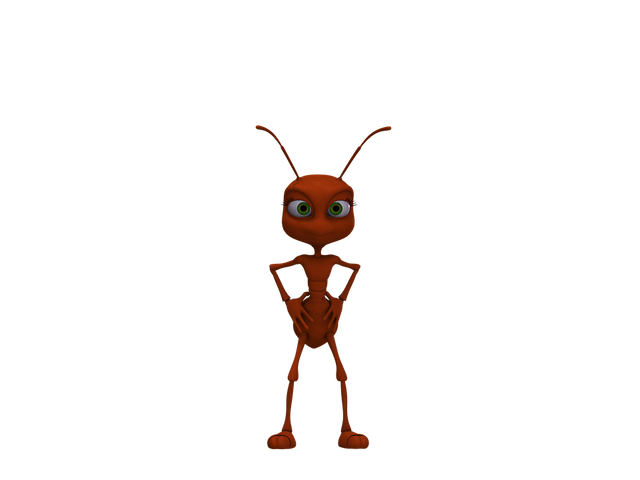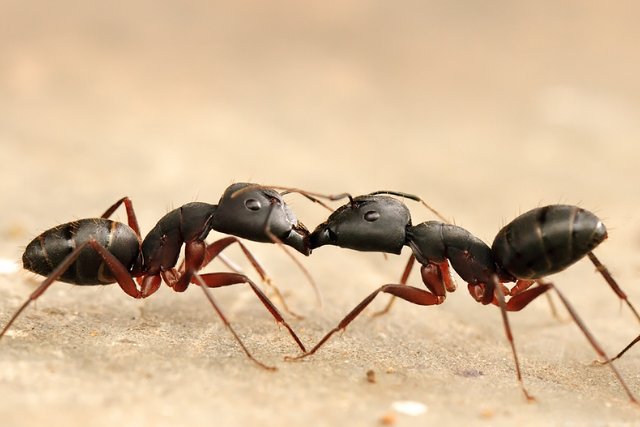How to talk to ants: touches and smells
In my last post about ants, I mentioned the book by Jae Choe that I have started reading and how that book describes the economics, culture, and politics of ant society, in that specific order.
I decided not to follow that order, though, and I started reading the section on the culture of ant society. And there, I began with the part on ant communication. This has a little bit to do with my own fascination with human communication, or more precisely, the lack of it. Having the most advanced tools of communication at our fingertips, we seem to understand each other so little that it is astounding.
So the question for this post is this: How would you talk about your ideas if you were an ant? After all, there has to be some kind of communication in order to maintain an orderly colony of thousands or millions of animals. And everybody needs to know how to tell the queen from the nobody. Add to that the fact that we know they have at least some kind of politics, and talking to each other becomes a necessity.
Let us assume for a while that you are a worker ant, a young forager. One sunny afternoon, you walk out of your dark, cozy home, and with ready antennae and sharpened jaws, prepared for what may come, you set forth into the wilderness to look for adventure and food.

Adventure! Here I come!
Source: pixabay
And like the careful ant that you are, you remember to leave that trail of pheromones to guide you back home.
What are these pheromones?
We need to talk a little bit about pheromones here because they are the most important tools of ant communication. In simple terms, they are chemicals that the ants secrete to convey messages to their nest-mates, who can "smell" the chemicals using their antennae. A variety of pheromones are secreted by an ant, and the number goes from ten to twenty depending on the species. There are distinct pheromones for trail-marking, for raising an alarm, and for identifying the queen or the soldier.
A complex combination of these pheromones is used by the ants to communicate with each other. Let us go back to the adventurous day and look at a few examples.
Back to the foraging
As you, the forager and adventurer, go exploring into the wilderness, you suddenly smell some food in the air, and the smell seems to be drifting towards you from your right.
Wait. How do you know if it is coming from the right or the left?
Smelling with the antennae
Those two antennae that you carry around are so sensitive that if the smell drifts towards you from the right, the right antenna will have a stronger response compared to the left antenna, and so you conclude: "Food to the right." You could call it stereo smelling.
And back to the foraging again
And then you march happily towards the right, and you finally reach the source of the smell, and it is a tasty dead earthworm! You bite into it and quickly realize that it is too heavy for you to carry home alone. So you swallow as much of the delicious juice as you can and you follow the pheromone trail that you left on your path and start walking back to your nest to get some help. You leave a stronger pheromone trail this time, because this path is useful, and you certainly don't want to lose your way after you ask your friends to help with the worm. That would be embarrassing.
On the way back, you meet another ant going towards the worm that you found. But you do not know whether this is friend or foe! So you two go ahead and touch antennae in greeting, and you are relieved to see that it is indeed a nest-mate. But how do you know?
Pheromones again
The answer is pheromones again. Chemical cues are used for identifying members of one's colony and even for telling the queen from the worker, for example.
I wanted to dig a little bit deeper into this, and I read the section on ant communication in a book called The Lives of Ants. The authors suggest that as ants from a nest touch antennae, their individual smells (which depend on everything from the species to the individual diet) blend together to form a common identifying smell. This technique does not seem to be full-proof though. The authors of a study on slave-making ants report a "propaganda pheromone" that the slave-makers will produce in order to confuse their victims. This pheromone will confuse those poor ants so much that they will start fighting among themselves while the slave-makers watch and plan.
But you are propaganda-free
You have not been subjected to the propaganda pheromone, so you will be friendly to the nest-mate you just met, and you will let her taste a little bit of the food that you swallowed earlier in a gesture that looks like a kiss. This will encourage her to help with the carrying of the worm, too. If she likes the taste, I suppose.

It will make a nice dinner! Ants practice mouth to mouth feeding in a process called trophallaxis.
Image created by Rakeshkdogra. Source: Wikimedia Commons
Mouth to mouth feeding
This process of transferring food through mouth to mouth feeding is called trophallaxis and ants seem to do this for a number of reasons including feeding the queen and larvae, and for the creation of that common nest smell that we talked about earlier. For this purpose, they have a special stomach called the "crop stomach" or the "social stomach" separated from their own personal stomach.
You just recruited a worker!
Now your nest-mate is convinced that the food is worthy and will walk towards the worm.
You will keep walking towards your nest so that you can recruit other workers who will go and give a hand (or jaw) in carrying the worm back home. And as more and more ants take the pheromone trail that you created, they will in turn secrete more pheromone, and it will soon be a pheromone highway through which the worm will be carried home for dinner.
Quite a day, right?
Here is a video of Edward O. Wilson himself doing a little experiment with ant pheromones. He lays down a pheromone trail to lead the ants to some food that he has placed at the end of the trail. In a while, the ants obey his chemical instructions and do exactly what he wants them to do.
E. O. Wilson talks to ants
So that is how you talk to ants.
Even though ants seem to communicate a great deal by touching and sniffing, these are not the only ways in which they exchange information. They also use sounds, and in some cases even dances. I will be exploring these non-chemical methods of ant communication in my next post.
Let me know your thoughts on chemical modes of communication (or anything else) in the comments.
Links to the original sources have been provided in-line.
Do you have any idea how the pheromone profile that is used to recognize nest-mates is generated? I'm thinking it might be genetically driven, i.e. the ants born from the same queen produce the same profile. Or perhaps the queen generates a pheromone profile that all the ants copy.
I had the same question while doing my research because this information was not easily available. As I say in the post, it appears to be both genetic and environmental. While the colony can be expected to have similar genetic make up, since the odor of an ant will depend on the food it eats as well as the places it visits, it becomes necessary for the nest members to "groom" each other so that the smells mingle to give rise to a common "colony smell". The sharing of food also seems to be important for the creation of this colony specific smell. The ants apparently store this synthesized colony smell in a gland near their mouths and apply it on their body so that they smell right. This book talks about this phenomenon in case of fire ants (page 252), and mentions that an ant from an alien colony will be accepted with "less aggression" if it is covered in the colony's smell and that a member of the same colony covered in some other colony's smell will be received with hostility. In short, each member apparently contributes to the creation of the smell, and the smell of one ant will be a subset of the mixed colony smell.
It is amazing how these societies have developed these intricate way to protect themselves. I'm now imaging a special agent ant that infiltrates an enemy ant hive by covering itself in pheromones.
Wow how amazing ! Each living being on the planet has special senses of some sort, I'm amazed how whales can communicate in the deep waters. Pheromones being shared though that's a new one to me and fascinating knowledge thanks for sharing @zycr22
Thanks for reading! Animals do seem to be capable of fascinating things.
like all about ants
@minnowpond1 has voted on behalf of @minnowpond. If you would like to recieve upvotes from minnowponds team on all your posts, simply FOLLOW @minnowpond.
Hey i've write about mums can you read it , and give me vote if you like it
Support me
https://steemit.com/love/@mokh-tar/dear-mum-spoken-word
You know when I said "Let me know about anything you like in the comments", I did not really mean anything, right?
Thank sir for your post .i hope your next post
Thanks for reading. I am planning to post regularly about different aspects of ant life. :)
Very interesting post, love it and enjoy your day.
Thank you for reading. :)
Congratulations @zycr22, this post is the second most rewarded post (based on pending payouts) in the last 12 hours written by a User account holder (accounts that hold between 0.1 and 1.0 Mega Vests). The total number of posts by User account holders during this period was 1152 and the total pending payments to posts in this category was $1549.13. To see the full list of highest paid posts across all accounts categories, click here.
If you do not wish to receive these messages in future, please reply stop to this comment.